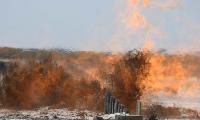Does Pakistan have the capacity to tackle the growing challenges of climate change? The country is running out of time, says a new report by the Global Information and Early Warning System (GIEWS) of the UN Food and Agriculture Organisation (FAO). Pakistan is one of the 20 countries that are at risk of receiving extreme rainfall in June. All this is based on the expected return of El Nino in 2023-24. During El Nino years (which translates into the warming of sea surface temperature every few years, typically concentrated in the central-east equatorial Pacific), our region is more prone to extreme rainfall. The effects of climate change in Pakistan became visible in 2015 when severe heatwaves killed thousands in Karachi. But this warning – that could have been turned into an opportunity to introduce a strong climate policy in the country – was conveniently and expectedly ignored. In 2020, floods in Karachi were again used for a political blame game with no action being taken to change course. The 2022 floods proved to be a stark wakeup call, prompting policymakers and people to think about their future. Last year, one-third of Pakistan was under water. Sindh and Balochistan – the worst-affected regions – are still dealing with standing water whose slow flow to the ocean is now creating multiple problems for residents. The country had barely recovered from the losses caused by the 2022 floods when another spell of rain in late March and early April destroyed large fields of the wheat crop.
The FAO report, coupled with the consistent signs by nature, calls for urgent decision-making. To understand the scope of government planning, it is essential to know the exact number of the country’s total population so as to ensure proper sampling and the subsequent allocation of funds. The census exercise that was supposed to end a few weeks ago has seen multiple extensions mainly because of loopholes identified during data collection. While the issue has always been political in this country, this time it is extremely important for the government to have the exact figure of the population in the country. Government machinery and rescue services will be of no use if authorities fail to know the extent of damage and the exact number of people looking for help.
Besides urgent emergency services, the government also needs to plan financial help for the affected. In this, our disaster management associations at both the federal and provincial levels need to be strengthened. A case in point is the Torkham landslide this month that resulted in the deaths of at least eight people. This is what the government needs to be planning for, without any time to waste. It should take preventive measures to either avert such disasters or at least ensure there is no loss of lives. Pakistan has only a month to prepare for extreme weather conditions that may begin in June. In urban Pakistan, all drains should be cleaned, and under-construction buildings/infrastructure should be fenced. As climate change leads to weather-related phenomena like floods and droughts becoming more frequent and extreme, we need to be better equipped to deal with these crises.
There are multiple reasons for this from authorities’ disinterest to lack of creative freedom
Fundamental issue that needs urgent redressal is political and economic alienation of Balochistan’s people
Country’s water shortage woes have reached critical level, and Sindh reporting an overall 50% water shortage
With court scheduled to hear matter again on April 29, inaction of government is becoming increasingly indefensible
Punjab Transparency and RTI Rules of 2014 do little to clarify mode of proactive disclosure
Recent cases of Peca trouble include journalists Farhan Mallick in Karachi, Waheed Murad in Islamabad and Shafiq in...







